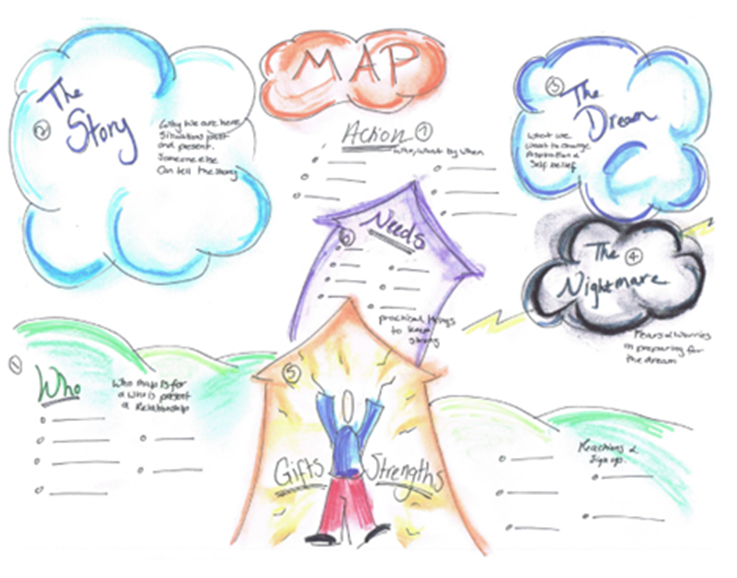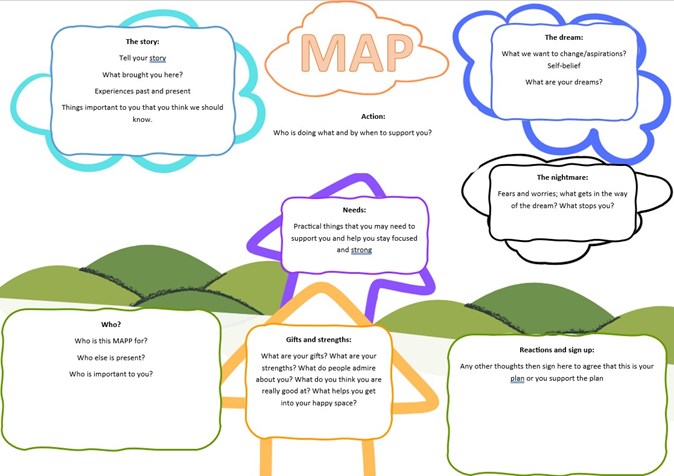For general services, training, communication and resources for schools please go to the Kirklees Business Solutions website.
- Local Offer Home
- SENDCO & Professional information and resources
- Support Plans (I-APDR, MSP's & IEP's)
Kirklees MAPP (Making Action Plans Personal)
The MAPP is designed to help with person centred planning and can accompany the I-APDR or can be used to support the "All about me" section of an EHCP.

Each area of the MAPP is described below:
-
The story: Tell your story, what brought you here? Experiences past and present. Things important to you that you think we should know
-
Who? Who is this MAPP for? Who else is present? Who is important to you?
-
Action: Who is doing what and by when to support you?
-
Needs: Practical things that you may need to support you and help you stay focused and strong.
-
Gifts and strengths: What are your gifts? What are your strengths? What do people admire about you? What do you think you are really good at? What helps you get into your happy space?
-
The dream: What we want to change/aspirations? Self-belief, what are your dreams?
-
The nightmare: Fears and worries; what gets in the way of the dream? What stops you?
-
Reactions and sign up: Any other thoughts then sign here to agree that this is your plan or you support the plan
You can draw a MAPP in any way you like, but we have created a Word template which you can download below:
Step-by-step guide to completing your MAPP (Making Action Plans Personal)
- Allocate to a keyworker who knows the CYP well and has an established, trusting relationship with the CYP
- Ensure you model how to complete the MAPP
- It can be completed in several sittings
- It needs to be a meaningful process and completed ‘with’
- Use visual prompts, open frame questioning, games etc. Be reflective and think out aloud. Direct questioning can shut a CYP down. They may not know what their strengths are etc and may say what they think you want them to say
- Model up and complete one alongside the CYP so they can get ideas from you
- Bring in relevant parties that the CYP wants to be a part of the process
- Draw, have fun! Doodle and let the CYP own the document
- Draw out any links to the EHCP if they are relevant and/or discussed
Steps
- Identify who the MAP is for and invite all in the room to introduce themselves and their relationship with the person.
- This is where the person tells their story and why they are here. The person can describe in detail situations past and present. If this is difficult the person can nominate someone to tell their story. The story should be recorded and then agreed by the person. This will allow the person to tell the story once.
- The dream is an opportunity for the person to say what they want to change about their life and express what their aspirations, hopes and dreams are.
- The person is then asked to talk through their fears and worries in preparing for the dream. This is referred to as the nightmare.
- The group then support the person by identifying and listing their gifts, strengths and talents.
- The group then thinks about the best way to move forward towards the dream and away from the nightmare for the person.
- The next stage of the process is to develop the action plan, listing who will do what, where and when
en-GBLast updated: 28/07/2023

